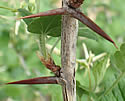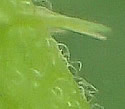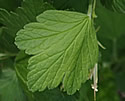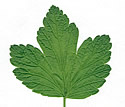Ribes missouriense (Missouri Gooseberry)
| Also known as: | |
|---|---|
| Genus: | Ribes |
| Family: | Grossulariaceae (Gooseberry) |
| Life cycle: | perennial woody |
| Origin: | native |
| Habitat: | part shade, shade, sun; dry to average moisture; woods, woodland edges, thickets, floodplains, fields |
| Bloom season: | April - June |
| Plant height: | 3 to 6 feet |
| Wetland Indicator Status: | none |
| MN county distribution (click map to enlarge): |  |
| National distribution (click map to enlarge): |  |
Pick an image for a larger view. See the glossary for icon descriptions.
Detailed Information
Flower: 

![[photo of flowers]](/udata/r9ndp23q/trees/ribes-missouriense-missouri-gooseberry_0423_120914-t.jpg) Dangling clusters of 1 to 4 stalked flowers arising from leaf axils on lateral branches. Flowers are ½ to ¾ inch long, narrowly tubular, pale yellow to greenish-white with 5 short, erect petals. Extending from inside the tube are 5 pale stamens that are 3 to 5 times as long as the petals. The calyx cupping the flower is pale green to whitish, the 5 sepal lobes are longer than the tube, much longer than the petals, but shorter than the stamens. Sepals are narrowly oblong with rounded tips, widely spreading to strongly bent back (reflexed). Between the calyx and flower stalk is a smooth, green ovary. At the base of the flower stalk are a pair of small, egg-shaped bracts that are finely hairy around the edge. Flower stalks are ¼ to ½ inch long and hairless, though the cluster stalk (peduncle) may have sparse, glandular and/or non-glandular hairs.
Dangling clusters of 1 to 4 stalked flowers arising from leaf axils on lateral branches. Flowers are ½ to ¾ inch long, narrowly tubular, pale yellow to greenish-white with 5 short, erect petals. Extending from inside the tube are 5 pale stamens that are 3 to 5 times as long as the petals. The calyx cupping the flower is pale green to whitish, the 5 sepal lobes are longer than the tube, much longer than the petals, but shorter than the stamens. Sepals are narrowly oblong with rounded tips, widely spreading to strongly bent back (reflexed). Between the calyx and flower stalk is a smooth, green ovary. At the base of the flower stalk are a pair of small, egg-shaped bracts that are finely hairy around the edge. Flower stalks are ¼ to ½ inch long and hairless, though the cluster stalk (peduncle) may have sparse, glandular and/or non-glandular hairs.
Leaves and stems: 

![[photo of leaves]](/udata/r9ndp23q/trees/ribes-missouriense-missouri-gooseberry_0508_153713-t.jpg) Leaves are ½ to 1¼ inches long and about as wide, nearly round in outline,with 3 to 5 primary lobes that are notched or shallowly lobed, the lobes and notches mostly rounded at the tip. Leaf bases are broadly wedge-shaped to rounded to slightly heart-shaped. Veins are prominent and radiate from the base.
Leaves are ½ to 1¼ inches long and about as wide, nearly round in outline,with 3 to 5 primary lobes that are notched or shallowly lobed, the lobes and notches mostly rounded at the tip. Leaf bases are broadly wedge-shaped to rounded to slightly heart-shaped. Veins are prominent and radiate from the base.
![[photo of hairs on leaf surfaces]](/udata/r9ndp23q/trees/ribes-missouriense-missouri-gooseberry_0508_154020-t.jpg) Surfaces are hairy, especially on the underside along major veins, and not glandular. Leaf stalks are up to ¾ inch long and densely short-hairy, often with a few long, feathery hairs but no glandular hairs.
Surfaces are hairy, especially on the underside along major veins, and not glandular. Leaf stalks are up to ¾ inch long and densely short-hairy, often with a few long, feathery hairs but no glandular hairs.
![[photo of lower stem]](/udata/r9ndp23q/trees/ribes-missouriense-missouri-gooseberry_0508_153435-t.jpg) New twigs are green, moderately to densely covered in short hairs and prickles, with 1 to 3 long spines at branch and leaf nodes. By the second year the bark on upper stems has turned gray, the thin bark often splitting to reveal brown stems with scattered light brown lenticels (pores). Prickles on the upper stems may fall away but the spines typically persist. Older bark lower on the lower stems is brownish gray, with persistent prickles and spines. Stems are erect to spreading and often arching, rooting at the nodes and where tips touch the ground and may create dense thickets.
New twigs are green, moderately to densely covered in short hairs and prickles, with 1 to 3 long spines at branch and leaf nodes. By the second year the bark on upper stems has turned gray, the thin bark often splitting to reveal brown stems with scattered light brown lenticels (pores). Prickles on the upper stems may fall away but the spines typically persist. Older bark lower on the lower stems is brownish gray, with persistent prickles and spines. Stems are erect to spreading and often arching, rooting at the nodes and where tips touch the ground and may create dense thickets.
Fruit: 
![[photo of fruit]](/udata/r9ndp23q/trees/ribes-missouriense-missouri-gooseberry-100_6893-t.jpg) Fruit is a smooth, round berry about ½ inch diameter when mature, ripening from green to reddish purple to purplish black.
Fruit is a smooth, round berry about ½ inch diameter when mature, ripening from green to reddish purple to purplish black.
Notes:
The Ribes species consist of both gooseberries and currants. Gooseberries are distinguished by at least some stems having spines or thorny prickles, which currants lack, and clusters of 1 to 4 flowers where currants have larger racemes of 6 or more flowers. While the flowers of Missouri Gooseberry are unique for the Minnesota Ribes species, when not flowering it is more difficult to distinguish. Prickly Gooseberry (Ribes cynosbati) is most similar in habitat and prickliness, but has glandular hairs on leaf surfaces and stalks, hairs on the ovary, and prickles on the fruits.
Native Plant Nurseries, Restoration and Landscaping Services ↓
More photos
 Missouri Gooseberry plant
Missouri Gooseberry plant Missouri Gooseberry plant
Missouri Gooseberry plant arching stem
arching stem prickles shed on older branch
prickles shed on older branch hairs and prickles on new twig and leaf stalk
hairs and prickles on new twig and leaf stalk more leaves
more leaves leaf scan
leaf scan
Photos by K. Chayka taken in Ramsey County. Other photos courtesy Peter M. Dziuk.
Comments
Have you seen this plant in Minnesota, or have any other comments about it?
on: 2018-07-29 15:31:57
5 years ago we removed a lot of buckthorn along our lake property in Eden Prairie hoping that the native plant species would return. Recently, I discovered an app called LeafSnap that allows one to identify plant species through taking a few pictures and uploading to their database. I was pleasantly surprised to see many good plants return, including Missouri Gooseberry. I have roughly 5 or 6 plants growing along our property line.






